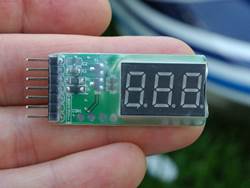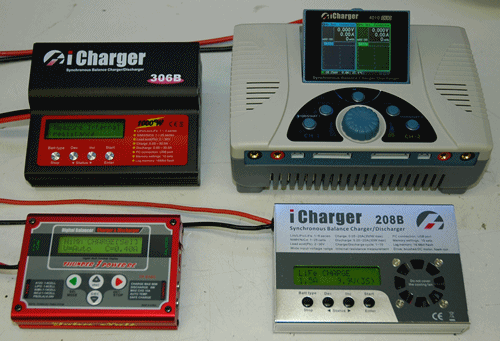RC LiPo Batteries
How to get the most life & fun out of them!
by John Salt - Last Updated March 2025
Questions related to RC LiPo Batteries are some of the most common I get.
I've built this page to answer all these great questions, along with other Li-Po battery tips, to help you safely get the most life, value, performance, and of course fun, out of your lithium polymer battery packs. Believe it or not, LiPo RC battery care & understanding involves more than just charge, use, recharge.
I've been into Li-Po powered RC flight for the better part of 17 years now, and have learned so much about this amazing powering method in that time frame; made some costly dumb mistakes too!
 LiPo Power Hungry Monsters
LiPo Power Hungry MonstersLarger electric RC helicopters and EDF jets are power hungry monsters; some peaking upwards of 8000 Watts (10HP) at the rotor shaft & over 140 Amps! If you can keep your LiPo's happy & healthy in a big heli or EDF jet, you can keep them happy & healthy in just about anything.
Listed below are the popular LiPo topics I'll be covering. Feel free to click on any topic you are interested in, or just scroll down the page to access them in the order they're listed.
RC LiPo Batteries - The Essentials
I also get asked about LiPo Battery Chargers all the time, as well as power supplies, Li-Po connectors, parallel charging, how to solder, and of course, "what's the best LiPo battery brand". Those links take you to the specific pages where I cover these topics in depth.
With that preliminary RC Li-Po battery stuff out of the way, let's get to it!
1. LiPo Battery Basics: Why Are LiPo Batteries So Popular In The World of RC?
LiPo batteries, short for Lithium Polymer battery, are a type of rechargeable battery that has taken the electric RC world by storm, especially for planes, helicopters, and multi-rotor/drone.
They are the main reason electric flight is now a very viable option over fuel powered models.
LiPo batteries have five main things going for them that make them the optimum battery choice for RC aircraft over conventional rechargeable battery types such as NiCad, or NiMH.
RC Li-Po Battery Pros
In short, Li-Po cells provide high energy storage density to weight ratios. They also give us a consistent voltage output, are capable of safe fast discharges, have quick recharge times, and can be configured in an endless variety of voltages, capacities, shapes, and sizes.
These benefits are important in any RC model, but for airplanes, helicopters, and quad/multi-rotor they are the reason electric flight has become so popular.
Face it, electric RC cars and RC boats have been around for decades; but it wasn’t until LiPo battery technology arrived on the scene that electric planes, helicopters, and quad/multi-rotor started showing up and are now surpassing gas, turbine, and even nitro in terms of power to weight ratios.
Why is power to weight more critical with RC aircraft? Because it simply takes way more power to get something airborne. Overcoming gravity uses substantial energy over something that drives on wheels or floats on water.
There are a few down sides with LiPo batteries however; once again proving there is no perfect RC power solution (yet).
RC Li-Po Battery Cons
- LiPo batteries are expensive compared to NiCad and NiMH. They have come down in price over the past several years, but are still quite costly.
- Although getting better, LiPo’s don’t have very long lifespans when used in high current demand applications like RC flight; perhaps only 200-300 cycles (much less if not cared for properly). The harder they are pushed, the shorter their life expectancy. If used gently however in low load applications (TX & RX battery packs for example), they can easily last well over 500 cycles.
- Safety issues - because of the high energy density storage coupled with the volatile electrolyte used in LiPo’s, they can burst and/or catch fire when mistreated.
- Because of this fire danger, RC LiPo's are classified as dangerous goods now by most shipping facilities world wide making shipping difficult, expensive, or even impossible for all but the smallest capacity LiPos.
- LiPo batteries require unique and proper care if they are going to last for any length of time more so than any other battery technology used in RC. Charging, discharging, storage, and temperature all affect the lifespan – get it wrong and a LiPo is garbage in as little as one mistake.
The Seven Main Things That Shorten LiPo Battery Life:
- HEAT
- LEAVING A LIPO FULLY CHARGED FOR EXTENDED TIME
- OVER DISCHARGING (voltage & current)
- OVER CHARGING (voltage & current)
- INADEQUATE BALANCING
- IMPROPER STORAGE VOLTAGE
- PHYSICAL DAMAGE (dropping, over tightening straps, prying cells apart, using too much/too strong Velcro etc.)
Before I start talking about the actual care & ratings of LiPo RC batteries, I thought I should go over the basics first.
2. How Are LiPo Batteries Made?
 LiPo Battery Plastic Pouch Cell
LiPo Battery Plastic Pouch CellAlmost every RC LiPo battery cell is packaged in a flexible plastic pouch, coincidentally called a "pouch cell".
The picture to the right shows both a single pouch cell, along with three of the cells combined to create a typical 3 cell (3S) LiPo RC battery pack.
Pouch cells are the perfect solution for building multi-celled battery packs because the flat pouch cell can be stacked with no wasted air spaces like found within round celled battery packs.
Since LiPo’s use this light weight plastic pouch instead of a metal can, less weight is the result making pouch celled LiPo’s the preferred choice in weight conscious RC aircraft applications.
By contrast, heavier canned lithium cells such as the very popular Li-Ion 18650 cells that are used in everything from cordless power tools, to Tesla Motor's current battery packs, weigh in at 20% or more than similar capacity LiPo pouch cells.
These LiPo pouch cells also allow for more thermal expansion and even gassing (electrolyte decomposition) due to the flexible pouch over a metal can that most Li-Ion cells are encapsulated. So, they can also been considered as a safety feature to some extent.
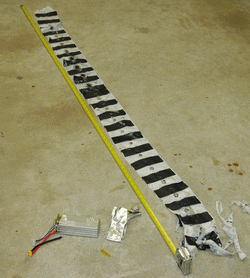 The "Guts" Inside a LiPo Cell
The "Guts" Inside a LiPo CellIf you ever open up a LiPo pouch cell (not recommended), this is what you'll find.
A long piece of very thin white plastic micro porous film with the thin lithium carbon coated aluminum & copper anode & cathode electrodes laminated in an alternating pattern on the front and back side of the separator film.
This long film (over 7 feet long in the case of this 5000 mAh cell), is folded accordion style back and forth upon itself resulting in an alternating anode/cathode stacking.
This
entire folded cell matrix is placed & sealed into the soft plastic pouch, and will be saturated with a greasy/gel like solvent based lithium ion infused organic polymer electrolyte; which incidentally is where these batteries get their name. This electrolyte has a very sweet solvent
smell much like nail polish remover/acetone.
If you ever smell that unmistakable sweet solvent like odor from a lipo battery pack, it has a leaking cell and should not be used under any circumstance!
Before the final heat sealing of the pouch, it is pressed under a fair amount of pressure to ensure maximum contact is obtained between the polymer separator film and the anodes and cathodes. The tighter this lamination between layers is, the better the ion transfer efficiency and lower the internal resistance of the battery.
This pressing of the cell just before final sealing also removes any remaining air within in the cell. Low humidity, clean room manufacturing environments and a high degree of quality control practices are very important which adds to the manufacturing costs of lithium batteries.
Tip: The only reason I had that damaged cell to open is because I dropped this heavy 6S 5000mAh LiPo pack on the hard concrete
floor. Lesson learned, don't carry more LiPo's than
you can safely hold.
Here's an interesting video of the processes involved in manufacturing LiPo cells & packs.
Hard Case vs Soft Case RC LiPo Batteries
As shown in that manufacturing video above and in the photo below; hard case LiPo's use a hard plastic shell to house the soft plastic LiPo pouch cells of the battery pack.
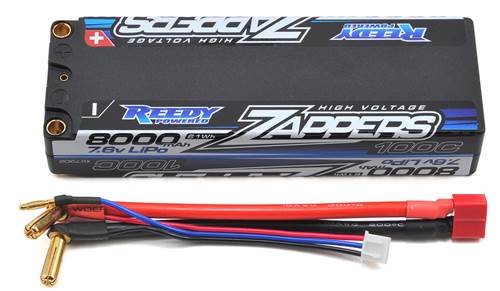 Hard Cased RC LiPo Battery Pack
Hard Cased RC LiPo Battery PackThis gives them added protection from moderate impacts and rough use that often occurs with ground RC vehicles such as cars and trucks; where saving weight is a secondary concern over that of protection.
Naturally this is vehicle dependent as some RC cars and trucks offer good physical battery protection. This is also application dependent; racing with other vehicles is likely to see more "impact" events for example.
Many hard cased packs as also shown in that photo have built in bullet connectors within the case to accept the main power and balance wiring.
RC air vehicles however (helicopters, planes, and quad/multi rotors), generally use soft case RC LiPo batteries.
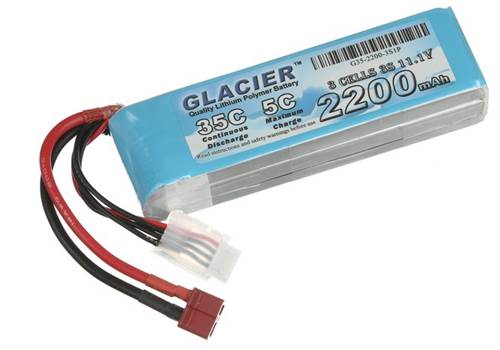 Soft Case RC LiPo Battery
Soft Case RC LiPo BatteryAs shown with the above soft cased LiPo, the cells are simply encased in a light weight shrink wrap to create the battery pack. There may or may not be a thin, light weight layer of foam protection also wrapped around the pack before the shrink wrap is applied.
Both power and balance wiring is soldered direct to the cells within the pack further reducing weight and avoid more failure prone connection points.
The main advantage to a soft case is obvious - less weight and a smaller form factor as there is no bulky case around the cells.
The other advantages with soft cased RC LiPo batteries is you can see when they are puffed or swollen. Hard cased packs on the other hand can have puffed cells totally hidden within the case, but the hard case will usually burst when the puffing gets bad enough. LiPo cells enclosed in thin heat shrink also have moderately better heat dissipation over ones that are enclosed in a hard case.
So, for electric powered RC aircraft, the vast majority of us will use soft cased LiPo packs for those primary advantageous reasons.
3. RC LiPo Battery Ratings (link to my full article)
4. LiPo Discharging: Over Discharging LiPo's! The Most Common & Destructive Mistake Made.
Okay, if there is only one thing you get out of this entire page, that is to understand how damaging it is to over-discharge a LiPo battery.
LiPo battery cells/packs will heat up fast and be irreversibly damaged when over-discharged, especially when under load. The larger the load, the worse the damage.
The over-discharged threshold value to remember is never lower than 3 volts per cell while Under Load (ie. being used).
Even if you have a 60C pack and can only draw one quarter that amount of power, if you push it hard right down to 3 volts per cell under load - it will become very warm/hot and will shorten its life substantially. You may even boil off some of the electrolyte causing the pack to "puff" (more on battery puffing further down the article).
Most ESC (electronic speed controls) have what is known as LVC (low voltage cutoff). This is a safety feature that is suppose to prevent LiPo's from being over discharged past 3.0V per cell during use. In my experiences, LVC is nothing more than a last ditch effort to avoid maximum battery harm and certainly not something to rely on.
If you fly/drive all the time to LVC, when the ESC either powers down the ground vehicle or reduces power to the air vehicle (giving you time to land), your RC LiPo batteries will live very short lives. Even when the LVC is set to 3.2V per cell under load, that is still over discharging the battery and causing harm.
Any heli or plane I've flown with a 3.2V LVC right down to the point of LVC activation, the pack has always been over-discharged. If you want to play it safe, set your LVC cutoff at 3.4V per cell. I personally don't trust LVC for safe and long RC LiPo battery life as voltage under load is not a good indicator of state of charge in a LiPo battery. Loads can vary as well, and that too gives erroneous states of charge voltage readings.
So how do you know when to stop flying, driving, or boating?
THE 80% LIPO BATTERY RULE TO THE RESCUE
A very good rule to follow here is the "80% rule". This simply means that you should never discharge a Li-Po pack down past 80% of its CAPACITY to be safe (80% discharged in other words).
For example, if you have a 2000 mAh LiPo pack, you should never draw more than 1600 mAh out of the pack (80% x 2000). This is assuming a healthy pack as well that has the full 2000 mAh capacity (as packs age, their capacity drops).
This again is where computerized chargers pay for themselves many times over so you can see how much capacity the battery takes allowing you to adjust your flight times accordingly to stay within that 80% rule to get the most life out of your pack.
If you don't have a computerized charger to confirm the amount of capacity, another good indicator is to measure the open circuit voltage (no load voltage) of the pack or individual cells right after a flight/drive with a digital volt meter or other similar digital voltage measuring device. An 80% discharged LiPo cell, will give an approximate open circuit voltage of about 3.74 volts.
A 3S LiPo pack therefore would show about 11.22 volts after a flight when it's about 80% discharged, a 6S pack would be in the 22.44 volt region. The longer you wait after the flight/drive, the less accurate this voltage method of determining an 80% percent discharge works because as the pack rests after the flight, the resting open circuit voltage recovers slightly.
I for instance use these little inexpensive AOK LiPo battery monitors after most flights to gauge my flight times to ensure I'm not over discharging my packs past 80%. These ones I use work with 2S to 6S LiPo packs.
They are also very useful to quickly identify fully charged and discharged packs when you get them mixed up by mistake so you don't accidentally put a discharged pack in your machine thinking it was fully charged.
Not sure about you, but when I go out for a full day of flying, I can easily have a dozen LiPo's on the go and it doesn't take much more than a simple interruption or memory lapse to get packs mixed up.
You just plug the little AOK rascal into your balance plug on your LiPo battery after the flight (or drive) and it will show the voltage of each individual cell in sequence, followed by the full voltage of the LiPo battery pack.
Simply one of the most useful little items in my field box.
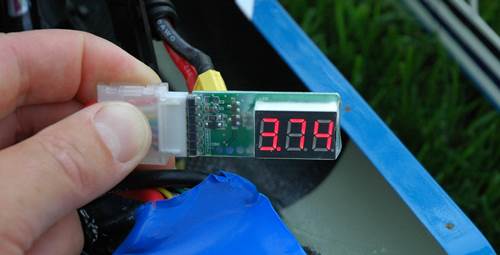 Checking 80% LiPo Discharged Voltage
Checking 80% LiPo Discharged VoltageYou can see in the photo above I have plugged the little monitor into this particular 5000 mAh 6S pack's JST-XH balance plug in a Bell 206L scale heli that I just finished building to get an idea of flight times to correctly set my flight timer. All cells in the pack were showing about 3.74V after this 8 minute flight which again is pretty close to an 80% discharged state.
So I set the timer to 8:00 minutes and it's working great (confirmed by charging the pack on a computerized charger to see how much capacity it takes). It should take about 4000 mAh of charge (80% x 5000 mAh).
Speaking of timing your flight, this is the standard way many of us use to know when to come back and land. All computerized RC radios these days have throttle stick activated timers for this very reason.
I "usually" find timing a flight just as accurate
as having some sort of low voltage monitor or telemetry voltage
warning for the exact same reason I mentioned above; voltage readings under load give unreliable state of charge accuracy because loads are always changing which cause the Li-Po battery voltage to dip and spike as well.
That said, if you have telemetry to monitor real time flight battery voltage - USE IT.
Telemetry is now offered on more and more computerized RC radios and is coming down in cost every year it seems. It's such a wonderful tool we now have that will warn you if a cell in your pack is taking a dump during the flight or the pack is draining unusually fast for some weird reason; both of which timing won't catch.
Lastly, you may have simply put a discharged pack in your bird thinking it was fully charged (guilty as charged on more than one occasion), and telemetry will save the day.
All 3 methods in other words (timing, telemetry, and capacity during charging), will ensure your LiPo packs are rarely being over discharged. :-)
80% Rule Caveat For Aggressive Flying
There is a caveat I should mention regarding the maximum 80% discharge rule, and that is for aggressive/hard 3D type flying or models that pull high current (EDF jets for example). When you are really flying hard (consistently drawing lots of current out of your batteries), the 80% rule is in my opinion over discharging and likely shortening the life of your LiPo.
For really aggressive flying or high current drawing models like EDF's, I feel nothing past 70% discharged is much better for the pack. This would be about 3.78V per cell right after the flight.
"I Just Over Discharged My LiPo - Is It Permanently Damaged Now? Can I Still Use It?"
Oh boy, I get this question a lot.
I'm afraid there are no hard rules here. I've certainly done it myself more times than I care to admit in my early days of LiPo powered RC flying and to this day, still mess up at least once a year when I'm not paying attention or I'm forced to stay airborne longer than intended for one reason or another (missed approach, hazard to avoid etc.)
Yes, the batteries are more often than not damaged when it happens. So much depends on the quality of the battery, size/capacity of the battery, how it was being used when it got over discharged, and how hot it got.
For example, if you were flying/driving and sucking a fair amount of current when your Li-Po dropped to, or under 3 volts per cell, it's pretty much a given that the cell/battery got hot and has had a large amount of its usable life just sucked out of it. It may not even be safe to use again. The larger capacity the battery and higher the current draw, the more likely damage will occur from the heat and gassing that's produced when over-discharging.
On the other end of the "abuse spectrum", if you over-discharge a LiPo battery down with very little current, it may be okay. Again, it all comes down to how much heat is generated when it's being over-discharged. The more heat, the worse the damage.
I have for example, over the years accidentally left a few LiPo RX (receiver) batteries powered up for several days (sipping milliamps), and by the time I realized my total brain-fart, they were dead. I mean stone cold dead - zero volts! Paper weights with no voltage potential whatsoever.
The only way I could even get them to charge was to force voltage into them until they built up enough voltage potential that my LiPo charger would allow me to start a normal LiPo charge cycle at a slow charge rate (0.5C or lower).
A few, not all were fine. Again, it all depends on the load that is being drawn and very likely the quality of the battery pack. I've done the same thing with some TX (radio) LiPo packs, and every single one was toasted! Of course catching them as soon as you can to hopefully bring them back to life will help your odds substantially. If they sit fully discharged for days or weeks, they will puff and degrade.
Some of those RX LiPo packs are still going strong after 8 years, but again, these are in low current applications. A main flight pack on the other hand, I would be very suspect of moving forward, even if you were able to get it to charge up and it seems to work.
You would certainly want to check how healthy such packs are, and often to make sure they are not about to take a mid flight dump on you or light the race track up in a flaming ball of carbon fiber glory.
5. Li-Po Battery Internal Resistance (link to my full article)
6. Charging LiPo Batteries (link to my full article)
7. LiPo Battery Balancing (link to my full article)
8. RC LiPo Battery Safety
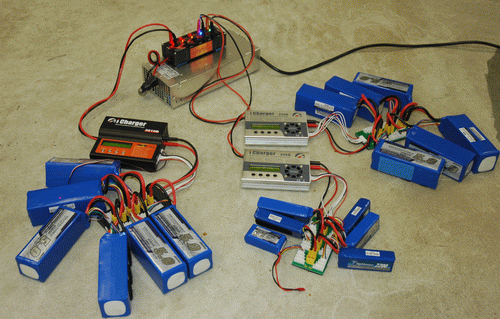 Charging LiPo's On The Concrete Floor
Charging LiPo's On The Concrete FloorI am not going to go into a lengthy safety speech here – there are enough warnings that come with Li-Po battery instructions that will give you all the information needed; specifically you should charge your LiPo’s in a fire safe area and never unattended. That last point is easy to print in the instructions, but rarely practical in the real world.
Personally I don’t have the time to sit down by my charging station in the workshop to keep an ever watchful eye on my LiPo packs charging - that is akin to watching the grass grow.
Here are my simple Li-Po charging safety tips that I follow:
- I usually charge all my larger multi celled LiPo’s directly on the concrete floor in the shop well away from any combustibles.
- I always wait at least 15 minutes after using a LiPo to let it cool down before charging it. This prolongs the life of the LiPo and prevents possible overheating and damage.
- I never ever leave the house (preferably the room) when charging LiPo’s.
- I store all my LiPo's in a metal tool chest in various compartments so if one goes up in smoke it hopefully won't take them all. Ammo boxes are also an excellent choice (remove the lid seal however). Cheaper still are hollow concrete blocks or even ceramic/clay flower pots can work nicely to if you don't mind the weight & bulk. Cement board can also be used to make custom RC LiPo battery storage containers.
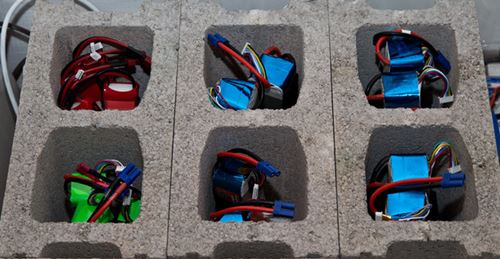 RC LiPo Batteries Safely Stored In Concrete Blocks
RC LiPo Batteries Safely Stored In Concrete Blocks- A visitor to my site told me about his very inexpensive safe charging area / storage solution - a used BBQ. You always see these things in the trash. Rarely is the housing of the grill damaged, they are tossed out due to internal burner corrosion or something similar. They offer great fire protection and are very much a "free" LiPo safety solution. Just might be the incentive to get a nice new shiny grill and use your old one for your LiPo's. A win - win ;-)
- Lastly
– I purchased an inexpensive smoke detector that I have mounted above
my charging area & storage chest so in the unlikely event a pack bursts during a charge
cycle or while in storage, the smoke detector will sound and I will be
alerted. I also have a small fire extinguisher mounted on the wall in my
workshop for any fire that may occur, not just a LiPo fire.
This all may seem excessive, chances are it is... but after watching the video below, I feel these are worthwhile precautions.
I should mention, I've had well over 200 Li-Po packs over the past 18 years now, and never has one started on fire, even when I try to get them to start on fire. Still, it's cheap insurance and makes me sleep better knowing I have taken & continue to follow those safety steps.
Most LiPo fires occur as a result of physical damage to the pack, (after a crash for example, or butter fingers dropping the pack on the hard concrete floor).
Over discharging the pack under high current loads can also let out the smoke and start a fire onboard your model as thermal runaway takes over.
Thermal runaway in a LiPo battery is a self sustaining reaction. Once started, this reaction keeps "fueling" more heat to be generated until the cell or entire battery puffs up, and might if you are very unlucky burst into flame. Remember, over discharging and heat are a Li Po battery's two worst enemies.
Fires can also occur during charging (charging at too high a C rating or at too high a voltage), and resulted from a
human error.
Keep all that in mind if you feel these batteries are too dangerous.
RC LiPo batteries are fairly safe if the rules are obeyed. They are basically as safe or dangerous as you are; but that's not to say there can't be the odd weird pack/cell failure due to a shorted wire, cell, similar.
LiPo batteries are high energy storage devices, and just like any high energy storage medium such as gas, nitro fuel, or jet fuel; a LiPo also has the ability to give off the energy very rapidly. The one difference with LiPo's however is they also provide their own ignition source.
9. Puffed Lipo Batteries (link to my full article)
10. Breaking-In LiPo Batteries
Breaking in a new LiPo pack is a good practice I feel, even though many say you don't have to do it. Just like a new engine, not pushing your new LiPo to the maximum limits the first few times out may give it added life and performance over the years.
Why?
Going back to that "ion exchange", breaking-in allows the pack's ion exchange efficiency to increase slightly to give the lowest possible internal resistance and best performance. It's not uncommon for example to see the internal resistance readings drop slightly after several uses of a brand new RC LiPo battery.
Some say breaking in also makes the electrolyte more stable and less likely to experience decomposition (pack puffing) when stressed. I however can't find any supporting articles or papers to back up such claims, just hearsay and anecdotes.
In all honesty, it's my opinion any good quality LiPo pack from a good brand doesn't benefit much from some complicated break-in procedure. Even if it did, the fact remains any slight gains that might be realized from such a procedure are going to be negated several to many times over by just one slightly over discharged or over heated flight or drive. We all do it.
Still, I feel it's worth giving your LiPo packs (especially big capacity costly ones) every chance for a good start in life considering how easy the process can be and how costly large LiPo packs are to replace.
The break in method I follow is very simple... For the first few uses (perhaps 4 or 5), don't fly/drive too aggressively, keep the charge rates low (1C or lower), and don't discharge down past 50% of the battery's capacity. That's it :)
11. LiPo Battery Storage (link to my full article)
More Helpful LiPo Battery Pages
Below are links to more of my LiPo related pages:
- Best RC LiPo Battery Recommendations
- RC LiPo Battery Connectors
- LiPo Battery Chargers
- Power Supplies For RC Chargers
- How To Build Your Own RC Power Supply
- Parallel Charging LiPo Batteries
- RC Soldering For Beginners
RC LiPo Battery Conclusion
I hope you now have a much better
understanding of what makes an RC LiPo battery tick, what to expect, and how to properly care
for them. Hopefully saving you from a few costly, and potentially dangerous mistakes.
On top of all that, what I really wanted to get across is that even though electric powered RC flight may not seem as complicated or fussy as fuel powered; there is much more to it than most people first realize.
If you found this LiPo page & others useful, feel free to bookmark the page/s for your future reference as LiPo questions arise. Likewise please tell others and share it so we can all make electric RC'ing safer and of course more fun!
If you have a particular RC LiPo battery question that is not covered on this page or the others, feel free to contact me. It's LiPo battery questions just like yours that have made this and the other LiPo pages the in-depth resources they have become over the past decade.
